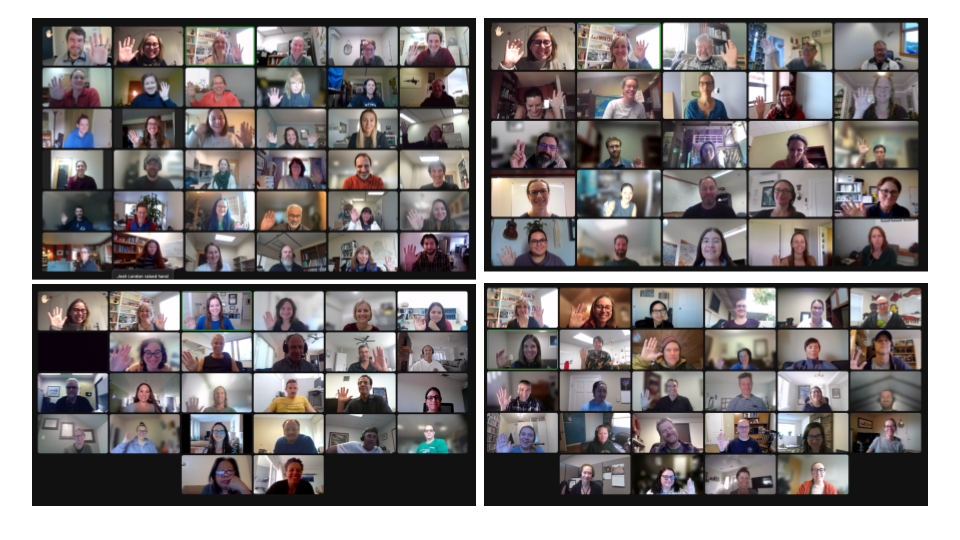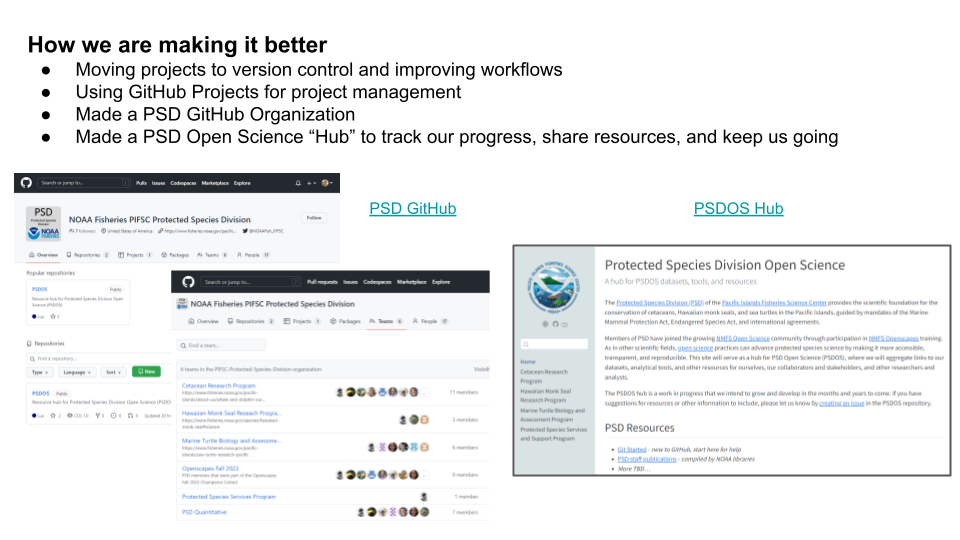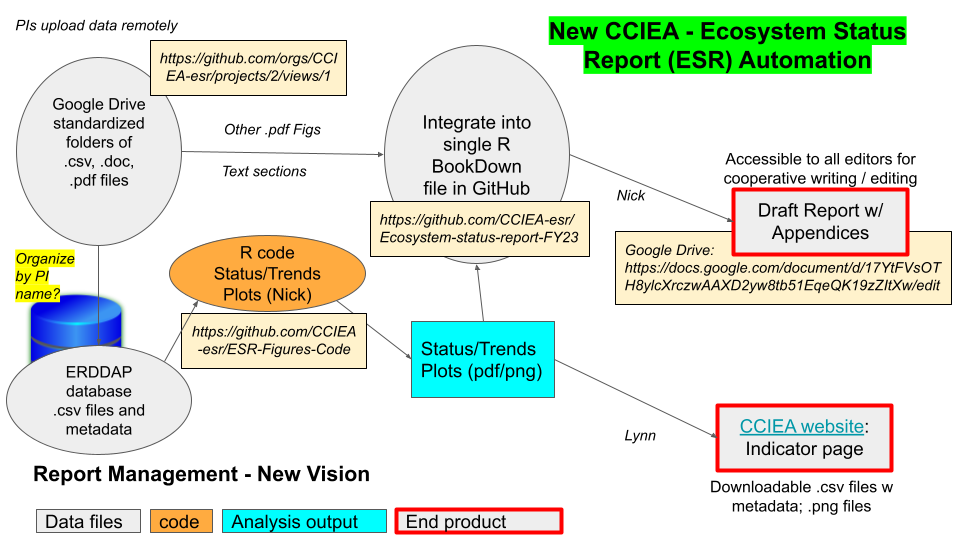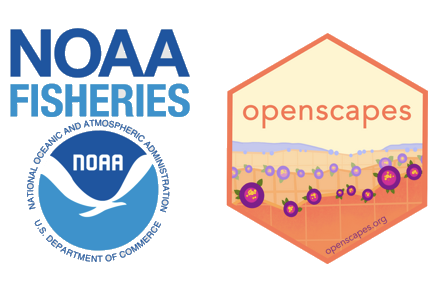Nationwide Openscapes Training at NOAA Fisheries Science Centers: Facilitating Collaboration, Skill-sharing, and Open Science
This blog post is co-written by NOAA Fisheries research staff who are Openscapes Mentors who supported colleagues during our four concurrent Champions Cohorts in Fall 2022. We’ll share what we did across all four Cohorts, as well as specific stories from each Cohort! We’ve also been building resources for NOAA Fisheries and beyond:
- https://nmfs-openscapes.github.io/
- https://nmfs-opensci.github.io/ResourceBook/
- https://rverse-tutorials.github.io/
Background: How NOAA Fisheries Openscapes Cohorts Worked
From October-December 2022, over 150 staff from six NOAA Fisheries Science Centers and two Regional Offices, as well as from the Office of Science and Technology participated in the Openscapes Champions Program, a professional development training program for transforming analytical workflows with open science. Through four Champions Cohorts and joint activities, NOAA Fisheries staff focused on developing a mindset for “future us” (Lowndes et al. 2019). We worked on developing a growth mindset to learn new systems and software, and practiced talking openly with colleagues and screen-sharing to improve how we work. We also learned about integrating new tools into our workflows, alongside real examples from NOAA colleagues from a previous Alaska Fisheries Science Center Champions Cohort of how learning these practices and tools in previous trainings have streamlined how they work.
Throughout the fall, we co-led these four Cohorts as NOAA Fisheries staff mentors, fostering a supportive work environment that embraced constant improvement and peer support. In addition to the bi-weekly facilitated cohort trainings where we learned from the Champions Lesson Series and discussed our experiences with colleagues, we supported free-form cohort coworking sessions to support our colleagues’ processes, and themed cross-cohort sessions with topics like Pathways, Quarto, GitHub project boards, and attributes of “Agile” open science team workflow concepts (NMFS Openscapes Fall Tutorials). In addition to the cohort sessions, we as mentors met as a peer-group across all four cohorts bi-weekly to debrief on the week’s sessions, refine planned activities based on revealed needs, and also skill-shared tech and facilitating tips. This peer mentor cohort is a core element of the goal of Openscapes to support, promote, and elevate local open science leaders in order to support sustainable organizational change.

What we did and learned together in our Champions Cohorts
Staff participated in Champions Cohorts as teams, reinforcing the idea that we’re not in this alone, and providing colleagues with whom we could not only practice concepts and tools but implement them in a real-life work setting to get our stuff done. For each of the teams, the Openscapes training was just the beginning of a longer process. Over the short few weeks of the workshop, the teams felt that Openscapes provided them with the support and space to tackle “wish-list” tasks (tasks they intended to do as a team for a long time but did not have dedicated time for), value their progress, and shift long-term practices within their workflows. While each team tackled very different challenges and goals (ranging from documentation, to report writing, to developing analyses) they recognized universal themes during the training: transparency, inclusivity, continuity, project management, and professional development.
The early weeks were devoted to exploration of the concepts of data and analysis pathways. Through discussions, teams identified common needs (through narratives and diagrams) to understand how data and analysis outputs were processed, stored, and incorporated into their own work. The process of writing out and discussing the entire workflow also helped teams understand the way the silo-ing of work (e.g., I do my job and then pass it on) led to low team awareness of issues (problems) and difficulty for the team to help itself (peer collaboration). Common themes were collaborative reports, moving toward databases, standardized formats and version-control of data, and away from Excel files emailed or in shared drive folders with ever-changing version numbers in multiple formats that each are ‘wrangled’ in different ways for each team member’s task. Teams were also eager to change to data and analysis processes that would allow reports to be written in Quarto or RMarkdown, and shared and versioned with GitHub. Thus creating transparent and more easily reproduced reports where the data, data wrangling, and analyses are all explicit (via code) within the report. This would also allow teams to migrate towards a report in multiple formats: pdf, Word and html, all generated from the same source.
Teams were not only focused on “tools”. Equally important were discussions around team communication: within the team and external to the team, for example, data and information providers and the end-users (e.g., regional offices or the public). This showed up as shared standard operating protocols, onboarding and offboarding procedures, and documentation. This was a way to put to practice the concept of “future us” for teams with turnover (particularly in remote and hybrid situations) and sustainably tracking inventories. Changing the nature and tempo of team meetings was also a theme. Many teams expressed that “coworking” sessions were helpful and eye-opening—these were not update meetings but rather times that people came to work on a task together, screensharing to expose and solve problems, and learn workflows from each other (for example: using gmail filters to manage calendar invites or GitHub notifications in a folder to be reviewed rather than streaming into your inbox).
The fall Openscapes training was a powerful opportunity for teams, and individuals, to step back and do a deep reflection and review their report or data science workflows. Adopting an open and growth mindset, they then worked together as peers and teammates to develop concrete ways to move toward workflows that embrace the open science ethos.
Specifics from each Cohort
Alaska Fisheries Science Center (AFSC)
AFSC supported 8 teams from 7 divisions across the center; 3 included cross-divisional partnerships. Teams focussed their energy on a range of important research issues supporting the AFSC mission including fishing tagging, fisheries survey design and preparation, marine mammals, genetics, shellfish, and fish life history. All of the teams developed their skills for improved analysis workflows, report writing, and manuscript preparation; promoting a culture of inclusivity and collaboration; intentional investment in on- and off-boarding processes; and integrated project management. All of this was achieved within the context of an expansion of open science within NOAA and the greater scientific community. The support and enthusiasm of AFSC leadership for AFSC to develop new skills and best practices is critical to AFSC’s continued organizational excellence.
“Before openscapes, our group had the beginnings of some momentum to create general, centralized protocols and analysis pipelines. The openscapes program really pushed us to the next level and gave us ideas of how to implement what we were thinking of designing for our group. Our advisor has supported us taking time to continue working on this organization and really cares about reproducibility. We are set up well to continue implementing our repos and shared resources.”
Pacific Islands Fisheries Science Center (PIFSC)
As our first time working with Openscapes, PIFSC staff across all four science divisions participated in the Fall Cohorts. Three of the PIFSC teams gave progress presentations at the final session. Highlights including the introduction of the Protected Species Division Open Science Hub (Figure 2), a clear vision of enhanced reproducibility, collaboration, and team culture from the Ecosystem Sciences Division team, and an improved pathway for processing published datasets from the Fisheries Research and Monitoring Division Life History Program team.
While some PIFSC staff have been committed to open science for some time, there is growing momentum to make these practices more widespread at PIFSC. Openscapes participants have been equipped with tools and a community to begin or continue practicing open science. We are sharing what we learned with our broader work teams, and plans are in motion to showcase PIFSC open science at a seminar in Spring 2023. Momentum is building to modernize our workflows and products. However, more capacity and training will be needed. In an email to Ecosystem Sciences Division leadership expressing support for future Openscapes training, Research Oceanographer Phoebe Woodworth-Jefcoats stated that Openscapes training was
“hands down the best training I’ve had in my 15+ years with NOAA.”

Southeast Fisheries Science Center (SEFSC)
This is the third Openscapes training that SEFSC scientists have participated in. The Fall 2022 cohort expanded this open science movement to every division in our Center. We have continued to build out tools initiated by previous participants, increasing our efficiencies and engagement in collaborative project management with GitHub project boards. The Population and Ecosystems Monitoring Division’s Trawl and Plankton Branch plans to expand their use of GitHub for cruise planning and version control programming to process and analyze cruise data (Figure 3).

SEFSC staff are building repositories of standard scripts and incorporating better review of data products, leveraging the Git version control software in the SEFSC Organization under the NOAA-NMFS GitHub Enterprise. Our GitHub Organization facilitates collaboration and onboarding and centralizes our intellectual property under unified NMFS standard operating procedures.
Southwest Fisheries Science Center (SWFSC)
This was the first time researchers from SWFSC participated in Openscapes! In her post for the NOAA Fisheries Science Blog, Biological Science Technician Kourtney Burger talked about the value of having Seaside Chats with her Southwest Acoustic Ecology Lab (SAEL) team and connecting with peers at other Centers.
“I transferred our recently revamped ADRIFT Field Methods manual to a Quarto web book. Previously, it was sitting in a google drive where it wasn’t easy to find and had accessibility issues. In just a couple hours, I was able to easily make a new repository, copy a Quarto template, and transfer the google document to a GitHub repository and an easy to navigate website!”
Northwest Fisheries Science Center (NWFSC)
This was the third Openscapes training that NWFSC scientists have participated in and as for previous Cohorts, this was a joint training with other offices. This provided a diversity of perspectives and helped participants understand the similarity and differences of data science tasks and challenges across the agency. A number of teams were participating for their second or third time and came with clear goals concerning improving workflows for the team’s large complex reports.

Conclusion
NOAA Fisheries is embracing cultural and technological evolution in our transition to open science. As part of this, we are taking strides towards standard best practices and secure IT workflows as it relates to internally and publicly sharing our scientific products, both in development and implementation. NOAA Fisheries scientists have put together a GitHub Vision Document and are working towards a GitHub Governance Team to pull what works from each Science Center. The result of these efforts will lead to a nationwide standard of more secure workflows, potentially more cost effective purchasing of tools, and more equitable distribution of these resources.
We’ve proposed additional partnerships with Openscapes via a 3-year grant proposal (with co-PI Holmes) that would further advance this movement. By creating more intentional opportunities (i.e. time and space) to seek and share guidance from one another, we inherently give our teammates a leg up on our respective starting points. When we critically and empathetically examine our workflows across teams, we foster an inclusive and psychologically safe work environment. We’re excited that the White House has declared 2023 as the Year of Open Science and to be part of this broader movement across government and science.
Thanks for reading! Please join us on January 26 at the ESIP Winter Meeting, where two of us - Adyan Rios (SEFSC) and Josh London (AFSC) - will share the success of movement building inside NOAA Fisheries, on a panel discussing “Better science for future us: Openscapes stories and approaches for the Year of Open Science”. Look for a follow-up blog and recording about this too!
